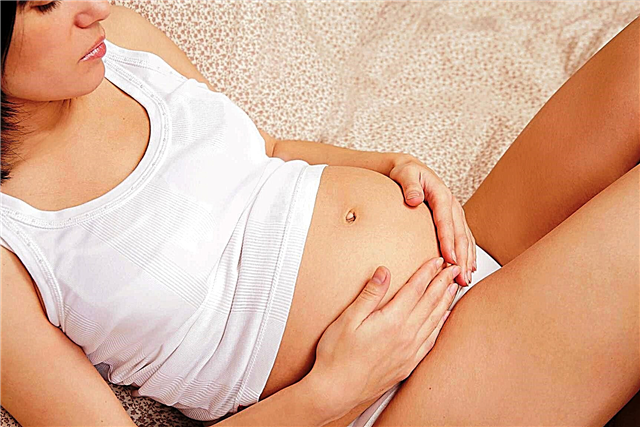
How the baby is growing and whether everything is in order with him, the doctor and spouses who are preparing to become parents will be helped by ultrasound diagnostics. At the very initial stage, when the size of the baby is still quite microscopic, the main criterion for the well-being of the baby is the so-called CTE. About what it is, what it can be, and what to do if there are deviations, we will tell you in this material.

What it is
The abbreviation "KTR" is not an analysis and not a research method, but the name of one of the sizes that are determined by an ultrasound doctor-somnologist. The contraction is a complex term - the coccygeal-parietal size. This concept means distance from the highest point of the crown of the embryo and fetus to the lower point of its tailbone in a position in which the baby's body is fully extended.

KTP is not height or total length, as some think. It's just segment from the head to the extreme point of the future spine, but for now - the neural tube. This parameter is measured from the earliest stages of gestation to 14 weeks.
After that, the baby becomes too large for the ultrasonic sensor to cover such a distance at a time, and the individual sizes of the child's body parts come to the fore, by which the doctor judges the proportions, growth rates and development of the fetus.

CTE begins to be measured almost immediately after the fact of pregnancy becomes obvious. To find out if there is a pregnancy at all, a woman using an ultrasound scan can at about 5 weeks, that is, 21 days after ovulation or about a week after the start of the delay of the next menstruation.
The coccyx-parietal size can be measured about a week later, in the sixth obstetric week, that is, about a month after conception.


The growth rate of the CTE informs the doctor about how the baby is growing. In the early stages, this is the only thing that can speak of the well-being or the disadvantage of pregnancy. The values of the coccygeal-parietal size are supplemented by data on the viability of the crumbs, because from about 5 weeks on ultrasound, a heartbeat is visible.
The tiny heart has not yet been fully formed, but the characteristic pulsation will not hide from the experienced gaze of a good specialist and a modern ultrasound scanning device equipped with a sensor with high image detail.

All babies grow at about the same rate in the first weeks of pregnancy. A little later, when the genetic characteristics of the child begin to appear, the ultrasound data in different pregnant women will have significant differences. With two pregnancies, occurring on the same day and even an hour, children will differ in size and body proportions, because they have different parents in build, different heredity, and different conditions for intrauterine growth.

At a short time, all embryos are almost the same, and they develop not due to hereditary characteristics, but according to the laws of nature. Therefore, the CTE is considered one of the most accurate methods for determining the duration of pregnancy. At the same time, the accuracy is up to every day after conception.
KTR does not depend on race, skin color, nationality of parents, ecology and geographic latitude. The only thing that can theoretically affect the coccygeal-parietal size is features of the health status of both the expectant mother and the baby himself, because even at a short time, literally from the first minutes after conception, all the information about what the baby's health will be is embedded in its genetic code - the karyotype.

How is it measured?
The only way to measure CTE is a sagittal scan. If the baby is moving too intensively, the doctor waits for the moment when he fully straightens up to take a freeze frame.
The sagittal plane visually divides the small body in half. The segment that the doctor lays from the crown to the coccyx is measured by a special program embedded in the scanner. The resulting value correlates with the existing tables, which indicate normal CTE values depending on the duration of pregnancy. The accuracy of the study is plus or minus 3-4 days.

In this way, this size allows you to establish the exact duration of pregnancy in the event that it is necessary... Such a need may arise in women suffering from an irregular menstrual cycle, who do not remember the exact date of the beginning of the last period. It is this date that is considered the starting point for the obstetric gestational age.
The first day of your last period is considered the first day of pregnancy. That is, the obstetric term differs from the actual one by almost 2 weeks or more.

The coccygeal-parietal size of the fetus will allow you to establish the exact time frame even if the doctor suspects a delay in the development of the embryo, because it is possible that ovulation occurred later than the woman thinks, or implantation occurred somewhat later than the average time frame. Then the actual age of the fetus will be less, which is what the CTE determined by ultrasound will tell about.

KTR norms
As mentioned, embryos grow at about the same rate if the pregnancy is progressing well. Existing tables are considered a fairly reliable way to assess growth and clarify the duration of pregnancy. Therefore, in relation to the coccygeal-parietal size in the early stages, no possible fluctuations of the determined parameter are indicated in the smaller direction.
The values are fairly accurate. But this is only for the smallest terms. As the baby grows, permissible errors in the CTE appear - the upper and lower threshold of the norm.

Table of normal CTE values and compliance with gestational age:
In this way, it is not difficult to establish the exact duration of pregnancy. The values in the ultrasound protocol for a particular woman can be indicated without tenths, only whole numbers. It all depends on how modern the device and the sensitive sensor were when taking the measurement.
Older machines define the value in whole numbers. The latest generation scanners, which are equipped with modern perinatal centers and clinics, can determine CTE with an accuracy of tenth.

You should not try to "adjust" your values to the average values up to every tenth. If, according to the results of an ultrasound, it is written that the CTE of the fetus = 1 mm, it can be 1.1 and 1.5 mm. If it is indicated that the CTE = 23.7, this corresponds to 9 weeks and 1 day from conception with an error of + 1 day. Similarly, CTE = 61 mm corresponds to a period of 12 weeks and 5 days, although tenths of the values in the table are different.

Possible problems and their causes
During pregnancy, women become incredibly sensitive, especially to everything related to the development and health of the baby. If there are no special problems in the early stages, the woman does not complain about anything, then there is no need to go for an ultrasound scan until 10-13 weeks. The first "meeting" of the mother with the baby usually takes place at the indicated time.
Naturally, it is the CTE of the fetus and all the related issues and problems that become an important topic for discussion in women's forums and in the communities of parents. The most common ones should be considered in more detail.

CTE less than normal
This situation is common, it is she who causes the greatest amount of suffering and anxiety in expectant mothers. The lag of the coccygeal-parietal size from the norm can be both physiological and pathological. For example, at 11 weeks, a baby in terms of KTP is barely close to 10 weeks. Naturally, the pregnant woman begins to get upset and look for the reasons for this phenomenon.
Not everything is so bad, experts say. Indeed, most often the reason lies not in the pathologies of the fetus and not in the diseases of the mother, but in a banal mistake that crept into the calculation of the term pregnancy. When a woman goes to a gynecologist about a delay in her period, and the doctor confirms the fact of pregnancy, he counts down from the first day of the last menstruation.

If the woman made a mistake with the date, then the date will be set incorrectly. If ovulation is late or implantation of the ovum into the uterine cavity occurred later, then the TRC will be less than the norm just for the period for which the delay occurred.
A second ultrasound scan will help to check or refute this version, which is usually prescribed a week and a half after the first ultrasound scan. The CTE in case of an error in calculating the term will increase in proportion to the actual term, and the further management of pregnancy will be carried out according to the corrected data.
The reason for the lag of the coccygeal-parietal size from the existing normative values may be fetal death. If the baby for some reason stopped developing, and the miscarriage did not occur, his CTE will be at the level at which he is at the time of death.

If the period is still small, and it is difficult to reliably determine the fact of the fetal heartbeat, then repeated ultrasound is desirable in 5-6 daysto make sure the baby is not growing.
In this case, obstetric curettage of the uterine cavity or medical termination of pregnancy without surgery is indicated (if the fetus is less than 6 weeks old). Further antibiotic treatment is possible.
With obstetric scraping, tissue samples of the embryo are taken for genetic analysis to establish the cause of its death. Most often, it lies in total chromosomal abnormalities, in which the further development of the embryo was impossible.

A lag in KTP values of more than two weeks is a reason for a more detailed examination. If the baby is alive and developing, but its coccygeal-parietal size is significantly different from the norm, the reason may be hidden in the hormonal background of the mother.
The lack of a hormone such as progesterone affects the development of the baby at the very beginning. If a blood test shows that the hormone is not enough, then hormone therapy is prescribed to the woman. With drug support, the hormonal background is normalized, and the baby will quickly begin to recruit what he "missed", the CTE will become normal.
The reason for the decrease in the coccygeal-parietal size may be the trouble that he experiences due to infectious or chronic diseases of his mother. The prognosis in this case depends on the specific disease or infection. If there is an opportunity to start treatment, the doctor will definitely prescribe it.

CTE over normal
The coccyx-parietal size may be more than normal, and this also worries expectant mothers. Exceeding this indicator is also typical for women who cannot remember exactly the date of the last menstruation. An error in calculating the obstetric term can also occur in women with early ovulation.
Earlier than the term, the release of an egg can occur due to a recent infectious disease, such as influenza or SARS, as well as in women who have taken hormonal drugs to treat infertility.

Thus, the period may be longer than the doctor expects, and the size of the CTE will unambiguously indicate this. To confirm or deny the version, the woman will be asked to come back to the ultrasound diagnostics doctor's office after about 10 days.
If the CTE grows symmetrically with the term, and at the same time it stably exceeds the norm by days and weeks, further maintenance will be carried out taking into account these adjustments. The dates will be recalculated, the estimated date of delivery will be postponed to an earlier date.
If the CTE of the baby is constantly at or above the upper limit, doctors may suspect that the woman has a tendency to develop a large or even giant fetus.
A baby who is born with a weight of over 4 kilograms is considered to be large in obstetrics. A giant fetus is a baby that weighs over 5 kilograms at the time of birth.

Such women are not recommended to take vitamin complexes, eat a lot, expectant mothers should visit a doctor more often. The very diagnosis of "large fetus" is not officially made at the beginning of pregnancy. This happens much later, in the third trimester. But the suspicion of a large or giant baby can arise in the early stages.
Do not assume that the trend towards a large baby is an excess of the CTE from the norm by 1-2 mm. The doctor can talk about a trend when, for example, at 13 weeks, the CTE at a rate of 63 mm and an upper threshold of 75 mm will be over 80 mm.
Before assuming a hero, mom will have her blood sugar checked. Often women with diabetes have a predisposition to have large children. Such a pregnancy will require special management and attitude.

CTE is growing slowly
Sometimes a woman may face a special problem - the slow growth of CTE. They talk about such a phenomenon if the embryo shows signs of life (from 5 weeks - heartbeat, from 8 - motor activity), but at the same time the growth of the crumbs is slowed down and over time lags more and more behind the existing norms. There may be several reasons for this phenomenon, almost all of them are pathological in nature.
Growth rates may slow down due to genetic pathologies. While the term is too short, it is not possible to establish this reliably. The first screening, which is carried out between 10 and 13 weeks inclusive, will be able to clarify the situation.

If the baby has congenital pathologies, special markers in the blood of a pregnant woman according to the ultrasound picture will affect the establishment of a high risk for Down syndrome, Patau, Turner or other pathologies.
It is clear that waiting and suffering for a woman is completely unbearable. The only way to find out if the baby is healthy before the screening is a non-invasive prenatal DNA test. It can be performed after 8 weeks of pregnancy in medical genetic centers and genetic clinics.
Blood is taken from a vein for analysis, and individual erythrocytes of the child can already be determined in it. The baby's DNA is isolated from them, and the probability of a chromosomal abnormality is established by the karyotype.

The analysis is very expensive - several tens of thousands of rubles, it is not available to everyone. Such an analysis is not included in the compulsory health insurance package, so it will not work for free.
The reason for the slow growth of the embryo may be the insufficiency of the endometrium of the uterus, if not so long ago a woman had an abortion. After termination of pregnancy, it is recommended to withstand a certain period of time until the onset of the next pregnancy, but in fact it does not always work out and not for everyone.
If this happens, and in addition to the low rate of growth of the CTE, the doctor ascertains erosion of the cervix or eversion of the cervix towards the vagina (ectropion), then the predictions are rather dubious. The risk of miscarriage is very high. A woman needs hospitalization, in a hospital environment there are chances to save the baby and give him the opportunity to grow and develop according to the term.

A slow "increase" in CTE is also characteristic of Rh-conflict pregnancy. If a woman with a negative Rh has already had several births or cesarean sections, and Rh-positive babies were born, then the sensitization of the mother's body can be so strong that antibodies will begin to build up literally from the first weeks of the next pregnancy.
In this case, the forecasts are also rather dubious. Everything will depend on the specific situation, the level of antibodies in the mother's blood.

CTE is growing too fast
Such situations rarely occur, but they cannot be ruled out.On average, up to 12 weeks, the growth of the baby is added by 1 mm per day, after this period the baby begins to grow faster. If the measurements were taken at 11 weeks, and then the ultrasound was repeated for some reason at 14 weeks, then the growth may indeed look rapid.
If growth increases above normal and at an earlier date, then the main reasons that doctors will consider are metabolic disorders in the maternal body, congenital fetal abnormalities and Rh-conflict. The rapid growth of the fetus by weeks can be accompanied by maternal problems with hyperthyroidism.

For how to measure the CTE of the fetus, see the next video.



